

|
Back to |
| The Front Page |
| People |
|
Rest in Peace, Mik Mehas |
||||||
|
by Rhys Thomas
|
||||||
|
||||||
Michael "Mik" Mehas, who died in 2009, is still remembered as the most polarizing player in the sport, and no one in the game knew him better than Rhys Thomas, who tangled with him on and off the court for more than 20 years. The two championship players learned together at the Beverly Hills Croquet Club and went on to become fierce adversaries on the court, then unlikely allies at the highest level of international team play. Mehas was a wildly colorful character who became well known from coast to coast, as much for his excellent play as for his unsavory antics. He was a tireless and endlessly inventive self-promoter. He made irresistably good copy for the press. Shortly after Mehas died, Thomas wrote this candid remembrance of the man who, without question, left an indelible mark on the sport. Croquet World had published an extensive obit, complete with quotes from many notables both praising and damning him, omitting much of the close-up factual truth. Nine years later, it's time to balance the record.
|
"It is a wise father that knows his own child. Well, old man, I will tell you news of your son: give me your blessing: truth will come to light; murder cannot be hid long; a man's son may, but at the length truth will out."
-- William Shakespeare, |
From day one, Mik was enthusiastic about the game and the skills needed to compete at the highest level. He showed considerable raw talent with exceptional single ball shooting and quickly became a regular croquet student on the Roxbury lawns. C.B. spent day after day, week after week, teaching both of us how to play American, Association, even Golf Croquet (and remember, this is 1988). We made each other better players.
That summer, Mik told me, C.B. and other BHCC members, that he once played baseball for the Los Angeles Dodgers. How cool, I thought, to have a former major-leaguer among us.
In those days, I was moonlighting as a sports stringer for the Associated Press in Los Angeles-mostly going to local college football games and gathering quotes for the bureau’s sports department. With access to the AP’s comprehensive baseball archives, I thought it would be fun to look up Mik’s lifetime MLB statistics. To my surprise, he had none. Zero. Nada. Zilch. Mik, it appeared, had never been a major-leaguer or signed a contract with the Dodgers.
I asked Mik about this the next time I saw him. His reply: "I was actually drafted by the Dodgers but ended up in the Philadelphia Phillies organization and also played minor league ball." Now more than curious, I checked the Phillies’ history of players-no Mik.
Mythical Mehas:
Movie producer, attorney, baseball big-leaguer
Months later, opportunity found me in the clubhouse at Dodger Stadium talking to manager Tommy Lasorda. I was there with a media pass doing some other story for Fox Entertainment News (my day job at the time). I’d met Tommy once before and when he saw me he immediately said "Hello Rhys, how are you?" In baseball, Tommy Lasorda is known for his uncanny ability to remember people. If you met him once, he never forgot. Knowing this, I asked Tommy if he had ever heard of a ballplayer named Mik Mehas? "Mehas?" he said. "No, never heard of him." I was beginning to learn more about Mik than I wanted to know.
Mik, it turns out, was a pretty good ballplayer. He lettered three years at Fresno State, 1960-1962. Those were banner seasons for the Bulldogs, winning two CCAA conference titles. In 1961, Mik’s junior year, FSU finished 36-9 and ranked 4th in the nation. As a starter on that team, Mik had promise.
Baseball didn’t have a formal draft in those days-that didn’t begin until 1965-but Mik somehow signed on with the Santa Barbara Rancheros in 1963. They were a Class A affiliate of the LA Dodgers. Mik had a good year in `63, hitting .288 with a fielding percentage over .900 playing 3rd base-the hot corner. I’m sure scouts looked at him as a viable prospect. Over the next two years, his batting average declined, but his fielding remained solid.
Sometime in 1965 Mik joined the Bakersfield Bears, a Class A affiliate of the Phillies. They sent him back to Santa Barbara and that was that. He never played pro ball again. Mik never told me when or how it happened, but he said his baseball career ended when a ball hit him in the eye. Looking at him, I believed that.
Why Mik told us he’d been a Dodger I’ll never know. All he had to do was tell us the truth about his years at Fresno State and in the minors, where he actually played alongside Don Sutton, Wes Parker and Norm Sherry. But instead, Mik inflated his reputation by telling us the big league lie.
Mik had a tortured relationship with the truth-it was a demon he couldn’t conquer. For some unknowable reason he could not help but spin a confounding web of deceit around nearly every aspect of his life. He told people he was an LA Dodger, based on a decent college and minor league career. He told people he was a lawyer, using his namesake son’s business card as evidence. He told people he was a movie producer, but his only credit seems to be as a gopher for a family friend, director and actor Nick Cassavetes.
Exile and banishment
And then he lied to us, his fellow members of the Beverly Hills Croquet Club, about the stupidest thing. Croquet balls.
As our club grew in the early 1990s and more players wanted court time, we realized the need to double-bank all the time, but we didn’t have any second color balls. To remedy the situation, C.B. and I took two of our older sets of Jaques balls and painted some stripes on them-distinctive Adidas-like stripes, three on each ball. Several months later one set of striped balls went missing. C.B. and I assumed they had been left out of the club locker overnight and lost to the croquet goblins. A month or so later, there I am, practicing at Stern Grove the day before the start of the San Francisco Open, when Mik shows up. He opens up his mallet case and, voila, a set of distinctively painted striped balls.
I asked Mik about the balls. He could have easily said, "Yes, I borrowed them from the club." But instead, he said they were his, that he had "bought" them. I asked from whom. He couldn’t remember. I knew they were the BHCC balls-I had painted them myself-but Mik was belligerent in his defense. All he had to do was say yes, they’re the club balls. But no, I was accusing him of stealing. Fighting words. If Mik loved anything in life it was a good fight.

|
| In 1992, the Beverly Hills Croquet Club was was the first of several to expel Mehas. The USCA club started as the playground of Hollywood actors and their friends, most of them now long deceased. Today the remaining croquet lawn is used mostly by gung-ho youngish 9-wicket players. |
To describe my relationship with Mik as contentious is putting it mildly. We were rivals from the beginning, both of us strong, upcoming players in the Beverly Hills CC, both of us destined for national and world class competition. Because I had a month’s jump on him from the start, my learning curve was ahead of his just enough to ensure a lot of early wins in friendly and tournament play. And we played a lot-almost every day for at least a year.
Chernobyl and the killer instinct
Mik was famous for playing the "out game," aka the "Chernobyl" opening in American Rules, pioneered by Archie Burchfield, Neil Spooner and Reid Fleming, promoted by Garth Eliassen, and devotedly practiced by our great mentor, C.B. Smith. C.B. played the Chernobyl open every single game of his life, or so it seemed, and so did Mik. Because of this, I worked hard to develop the skills and tactics to easily defeat the Chernobyl. As a result, Mik rarely played the out game with me in tournament play because I usually got the best of him when he did.
This is not to say that Mik didn’t use the out game to great advantage on the courts-maybe better than any other player in American croquet history. The out game perfectly suited his style of play and demeanor. It’s a bully tactic that always favors the better player. And that’s just how Mik played-like a bully. It didn’t hurt that he was an exceptionally fine shotmaker. He could shoot himself out of almost any jam. The tougher the shot, the better he was. And he had the killer instinct. He would do anything to win. Anything.
Dressing for the image
Even though Mik never played major league baseball, he had that major league ball-scratching swagger on the croquet court. Before starting a game, he’d walk up to you, spit in his hands, rub them together, then offer a sportsmanlike handshake. I learned to shake my head. He also became well-known for wearing his off-white baseball pants instead of the more traditional white shorts or long pants. And black shoes. When people complained, he wore pink Plus-Fours. Mik was going to make a statement with his attire as much as his mallet.
All this added up: Mik had a natural gift for self-promotion, attracting attention and pissing people off in the croquet world. Part of this had to do with his frequent literal pissing, often in the courtside bushes during tournaments. This led to grumbling, then complaining, then some edicts: Mik was told by tournament directors that he’d be disqualified if he kept peeing in the bushes. Mik complained about this-"I have a prostrate problem" he once wrote to me. I laughed at that-he had to lie down all the time? He wasn’t very good with the written word.
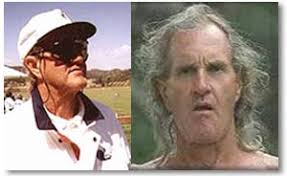
|
| Two faces of Mik Mehas (and there were many more). |
Pissing got him in trouble even when Mik was trying to do the right thing. It happened at the US Open in the early 1990s, at the Mission Hills Country Club in Palm Springs. At the opening reception, Tournament Director Stan Patmor read him the riot act about pissing in the bushes at the club.
"You do it once and you’re out," Stan said. So Mik did his best to be discreet, to his own detriment. It happened while I was double banking with Mik and I witnessed the entire episode, which played out like a tragic comedy of semi-Falstaffian proportion.
First game in the morning, beautiful day. A woman was eating breakfast on the porch of her courtside condo, casually watching us play. As usual, Mik had to go, so he politely asked the woman if he could use her restroom, rather than run all the way back to the clubhouse, which was a considerable distance. She said "okay"-I heard her. So Mik goes in her condo, does whatever, and expeditiously comes back out to continue his game.
Unfortunately, one of the croquet-playing Mission Hills club members saw Mik coming out of the lady’s condo and immediately approached her and asked her why Mik was in her home. The lady explained, and then the club member told her that she’d made a terrible mistake, Mik’s an axe murderer. Well, not quite. But that’s what reputations breed.
Mik was a scoundrel, no doubt about that, but never dangerous. Still, word of the pee break trickled back to Patmor, the players, and to other club members. Mik wasn’t kicked out of the tournament, but soon after that, he was banned from Mission Hills…for life. This would cause innumerable problems in the future, for Mik, for the Mission Hills Croquet Club, and for the USCA.
Because Mik remained a member of the USCA "in good standing," he could not be banned from USCA titled events. This meant Mission Hills fell out of the hosting rotation for USCA titled events. And Mik still played in all of them, and played well. Well enough to win many regional and national titles in singles and doubles.
Mik played great croquet and would be a USCA Hall of Fame candidate if he had just been able to get along with people, not piss them off. But he couldn’t help himself. Even when he was trying to be kind he managed to utter words that rattled people to their cores. And he didn’t quite get it. He could be an incredible charmer-the perfect snake-oil salesman-but the snake oil always floated to the surface.
Inventing the "bad boy" of croquet
In 1995 Sherwood Country Club in Thousand Oaks, California, hosted the USCA National Championships for the first time. I was the tournament director and took it upon myself to publicize the event. I wrote up a press release, describing the event and various players. Knowing how the media latches on to characters, I set out to describe a handful of the top players in the tournament, including Mik. To give him his due, and drum up some curiosity, I called him "The Bad Boy of Croquet." And because I was stringing for the Associated Press, the release went out on the national wire service. This generated considerable interest in the media. We had all the local papers, including the Los Angeles Times. Even had a camera crew from "Good Morning America" show up. And all of them wanted to talk to the "Bad Boy." Being a natural self-promoter, Mik ate it up. And a lasting nickname was born.
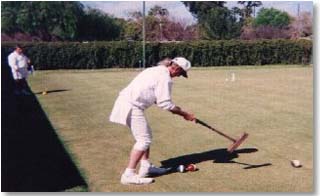
|
| In a three-game match against many-times world champion Robert Fulford of England in San Francisco, Mehas displays his standard press-worthy features--ponytail, baseball pants, and a white towel hanging from the waist--to dramatizes a sporty version of croquet form. |
Oddly, this is about the time that Mik and I came to an amicable understanding between us. I found his behavior crude and abrasive but admired his play to the point where I believed he was being unfairly judged when it came to USCA Team selections. If Mik was in "good standing" with the association, he should be eligible for team consideration.
Competing internationally with the American team
In 1996 I became chairman of the USCA’s selection committee. In this position, I reformed the committee, making it a players’ committee-those who’d "been there"-and sought to select the best possible players for our teams. In this capacity, I encouraged Mik and presided over his selection to several different teams, culminating in the 2000 MacRobertson Shield.
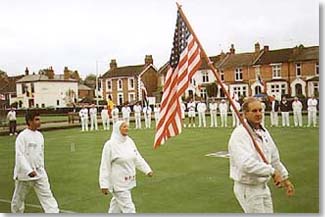
|
| A high point in both the real and the fantasy life of the bad boy--carrying the team flag in the opening ceremonies--was his remarkable and dramatic second-place finish in the 1997 Golf Croquet World Championship, a feat still not matched by an American. |
Mik did do some great things for croquet. He was, perhaps, the best person I ever saw when it came to recruiting new players into the game. He introduced Ruth Summers to croquet and anyone who knows Ruth knows how much she has given to support croquet. Johnny Osborn called her a "future Hall of Famer"-and true enough, she was. But without Mik, Ruth might never have entered a croquet tournament.
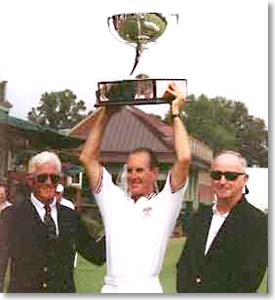
|
| In 1998 at the top of his game Mehas demonstrates perfect sports hero form as he holds aloft the winning trophy for the American Rules National Championship at Pennsylvania' s Merion Cricket Club, framed by Archie Peck and Jim Hughes. |
Mik was always hustling. Once, I asked him how he could afford to go to so many tournaments-those of us who’ve traveled the circuit know it’s very costly with little opportunity to recoup expenses. That’s when Mik told me about his movie producing career. Of course, that was a lie. What Mik really did was run a simple yet audacious auto insurance scam.
Mik had this classic white Rolls Royce, not a cherry by any means, but still a Rolls that, from afar, looked pretty good. When Mik started running low on funds, he’d roll out his Rolls and go driving, looking for an opportunity… in the rear view mirror. When someone got a little too close, especially if they had a nice car, he’d slam on the brakes and, Whamo! Repair estimates on a Rolls are not cheap, though Mik rarely spent all the money on repairs. He would also claim to have suffered whiplash or an injured back. The insurance settlements were considerable, and helped support his croquet habit.
Unfortunately for Mik, he ran this scam one too many times and he actually injured his back quite badly in one wreck. It took him out of croquet for almost a year. Of course, then he sued the unlucky rear-ender for lost wages in his "profession" as a "croquet professional." I know this because Mik asked me to vouch for him in an affidavit to the court. I refused. Mik and I could get along but I wasn’t going to be party to his web of deceit.
The gift and the grace of mortality
Soon after this accident, Mik nearly died when his kidneys shut down. He was hospitalized for a couple weeks and lost a lot of weight. It was months before he was back on the court, and he never really fully recovered. He certainly was never the same croquet player. But it did have a softening effect on his character and soul. After the accident, I could tell he was trying to be a better person. And he did become a kinder and gentler human being. Mortality does that.
The last time I saw Mik was in 2007. He looked awful, but was still playing. Most surprisingly, he apologized for many of the problems we’d had in the past. He also thanked me for supporting his selection to the 2000 Mac Team, He said it was the greatest croquet experience of his life. He truly enjoyed being part of that team, which finished 3rd in the contest-very telling from such a self-absorbed guy. I accepted the apology and thanks at face value, and in turn, told him how sorry I was for all our difficulties. On the court, Mik and I had a lot of great matches, matches I truly enjoyed.
A year or so later, he called me and told me he had a brain tumor. His new excuse, I wondered? Another scam for sympathy? Another lie? How sad to have thought that. Mik pegged out for the last time on July 12, 2009. He was 68 years old.
Those who read this may despise me for laying it all out, but I believe all true characters in life are accountable for all their actions. As my pal Rebo once told me, "we must live as if everything we do will be known by everyone in the fullness of time." Mik was talented, colorful and unsavory, and if nothing else, a true character people loved to hate, and still talk about to this day.
In Death, may Mik rest in the Peace and Light he sought in Life
Rhys Thomas
Los Angeles, Cal
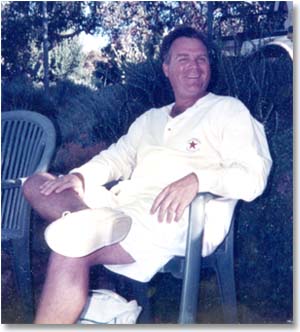
|
| Rhys Thomas courtside at Ink Grade Croquet Club. |